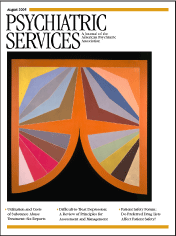Use of Mental Health Care and Substance Abuse Treatment Among Adults With Co-occurring Disorders
Abstract
OBJECTIVES: This study investigated patterns of use of mental health care and substance abuse treatment for a nationally representative sample of adults with co-occurring mental health problems and a substance use disorder and compared these patterns with those of persons with either a mental health problem or a substance use disorder. METHODS: Data were from the 2001 and 2002 National Surveys on Drug Use and Health. The study examined rates of substance use disorders and mental health problems among adults aged 18 years and older, rates of substance use disorders among adults with mental health problems, and rates of mental health problems among adults with substance use disorders. Next, rates of substance abuse treatment and mental health care use were calculated among five groups that were formed on the basis of the presence of a substance use disorder, mental health problems, or both in the past year. RESULTS: A total of 2,851 respondents had a substance use disorder only, 1,633 had a substance use disorder with one or more mental health symptoms and without serious mental illness, 1,872 had a substance use disorder with serious mental illness, 13,759 had one or more mental health symptoms only, and 7,530 had a serious mental illness only. A substantial proportion of adults with comorbid mental health problems and a substance use disorder did not receive any treatment (46 percent of those with serious mental illness and 65 percent of those with one or more mental health symptoms). Co-occurring substance use disorder was not associated with increased use of mental health care. The likelihood of receiving any substance abuse treatment increased with the presence and severity of mental health problems. Across all five groups, use of mental health care was more common than use of substance abuse treatment. Less than one-third of patients with comorbid mental health problems and a substance use disorder who used mental health care also received substance abuse treatment. CONCLUSIONS: The large proportion of untreated individuals with mental and substance use disorders reinforces existing concerns about barriers to beneficial treatment. Low rates of use of substance abuse treatment among patients who have comorbid mental health problems and a substance use disorder and use mental health care suggest that recommendations that substance use disorders be treated before, or concurrently with, mental disorders have not been widely adopted.



